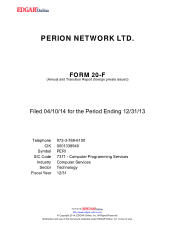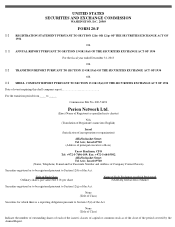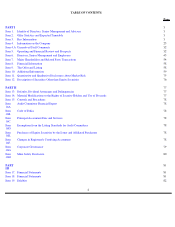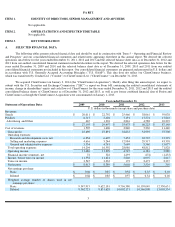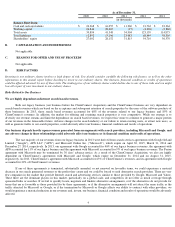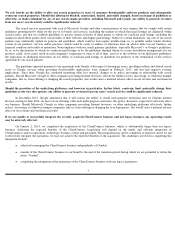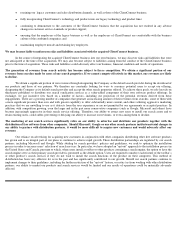Incredimail 2013 Annual Report Download - page 11
Download and view the complete annual report
Please find page 11 of the 2013 Incredimail annual report below. You can navigate through the pages in the report by either clicking on the pages listed below, or by using the keyword search tool below to find specific information within the annual report.
In order to receive advertisement-generated revenues from our search partners, we depend, in part, on factors outside of our control.
The amount of revenue we receive from each of our search partners depends upon a number of factors outside of our control, including
the amount these search providers charge for advertisements, the efficiency of the search provider’
s system in attracting advertisers and
syndicating paid listings in response to search queries and parameters established by it regarding the number and placement of paid listings
displayed in response to search queries. In addition, each of the search partners makes judgments about the relative attractiveness (to the
advertiser) of clicks on paid listings from searches performed on a toolbar or other search assets and these judgments factor into the amount of
revenue we receive. Changes to search partners' paid listings network efficiency, its judgment about the relative attractiveness of clicks on paid
listings from a platform-
generated toolbar or the parameters applicable to the display of paid listings could have an adverse effect on our
business, financial condition and our results of operations. Such changes could come about for a number of reasons, including general market
conditions, competition or policy and operating decisions made by Microsoft or Google or other search partners of ours.
Our ClientConnect business is highly reliant upon a small number of publishers, who account for the substantial majority of its pay-
outs
to publishers and, in parallel, its revenues. If the ClientConnect business were to lose all or a significant portion of those publishers as its
customers, its revenues and results of operations would be materially adversely affected.
In 2013, the top 10 publishers who distributed search properties of the ClientConnect business accounted for approximately 69% of its
revenues in 2013. There can be no assurance that these existing publishers will continue to distribute our search properties or continue utilizing
the revenue generating monetization services. The loss of all or a substantial portion of our relationships with these publishers would cause a
material decline in our revenues and profitability.
Under the pay-per-
install ("PPI"), model for payments to publishers, a timing delay between when expenses and related revenues are
recorded and if projected revenues are not estimated correctly, or, subsequent to payment, the revenue model changes, could have a
material adverse effect on our operating results.
In order to promote the distribution of our search properties, we to a great extent utilize a PPI model, under which publishers are paid
up-
front each time they distribute our search properties to an end user who subsequently accepts them. This particular payment model typically
has an adverse impact on our results of operations in the short-
term, as the traffic acquisition costs related to a given user are recorded as an
expense as incurred, when a user accepts our monetization services, whereas the related revenues are generated from that user only when and as
long as (if at all) the user performs searches, for which we receive payments from search providers. To the extent we incorrectly estimate the
expected revenue from the search activity of the end user over time, for any reason including changes in the market, our operating results will be
materially adversely affected.
In order to maintain revenues and continue to grow, we need to continually acquire new users and maintain user engagement with our
search services through technological advantages.
The market for search services is highly competitive, and we experience significant competition for user engagement with our search
services from other participants in the industry who use a similar search advertising business model. We generate the substantial majority of
revenues associated with online publishers that distribute our search properties during the first year after installation. In order to maintain current
revenues and grow our business, we need to continually maintain the technological advantage of our platform, products and other services, such
as our search protect software, which help us maintain user engagement with our search services and assist us in acquiring new users. If we fail
to maintain our technological advantage, user engagement may decline materially, which would have a material adverse effect on our operating
results.
Currently most individuals are using non-
PC devices to access the Internet, and most of our revenue generation and services are
currently not usable on these competing platforms.
We focus primarily on the market related to personal computers ("PCs"), which has accounted for all the revenues in our legacy
business and that of the ClientConnect business. To the extent that there is an even more significant shift by the market from PCs to mobile or
tablet devices, we would experience a substantial reduction in revenues. Recently, the number of individuals who access the Internet through
devices other then personal computers, such as mobile phones, tablets, etc., has increased dramatically. While we have begun developing
solutions for mobile platforms, our services, for the most part are not yet compatable with these alternative platforms and devices and we have
not yet implemented revenue generation models for mobile applications. If this trend accelerates, we may fail to capture a sufficient share of an
increasingly important portion of the market for online services, our services will become less relevant and may fail to attract advertisers and
web traffic. In addition, even if consumers do use our services, our revenue growth will still be adversely affected if we do not successfully
implement revenue generating models for our mobile applications.
7

